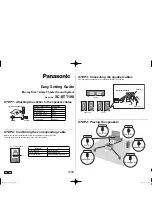
pressing the “arm/lock” or “disarm/unlock” button. Only the output itself
will stop- pressing either button again will normally operate the system, and at
any time after the 28 second lock output period ends.
If either of the programmable relays are set for lock or unlock operation (the next
two Programmable Features), the settings if this feature will operate the program-
mable relays accordingly, in addition to the primary system doorlocking outputs.
Feature #24 Unlock Relay Functions
Factory Default Setting
Door Unlock Output
(
press
“arm/lock” button to program
)
Options:
Horn Output
(
press
“disarm/unlock” button to program
)
Channel 5 Latch Output
(
press
“
II
” button to program
)
Channel 5 On Demand Output (
press
“
III
” button to program
)
This is the second of two built-in relays which can be programmed to perform
several different functions. As described above for the “lock” relay, the primary
function of this second relay is the “unlock” function, which in many cases is not
required and making the relay available for other uses. In the case of this relay, a
very popular application is operating the vehicle’s existing horn; either in conjunc-
tion with the electronic siren, or in place of the siren. Using both the siren and the
horn creates an extremely effective security system. The remaining options are
Channel 5, with the same operation parameters as described above for Channel 4.
See the wiring instructions on pages 14-17 for additional details.
Feature #23 Lock Relay Functions
Factory Default Setting
Door Lock Output
(
press
“arm/lock” button to program
)
Options:
Parking Light Output
(
press
“disarm/unlock” button to program
)
Channel 4 Latch Output
(
press
“
II
” button to program
)
Channel 4 On Demand Output (
press
“
III
” button to program
)
Both Crime Guard models have two built-in relays, which can be programmed to
perform several different functions. Although the primary function, or default
setting, of this relay is to operate as a door “lock” function, there are many vehicles
which don’t actually require a relay in which case the relay is available for the
optional functions. Other options for this relay are parking light flash, which has
the same operation as the White wire, and an additional remote output, operated by
the controller/transmitter’s “arm/lock” and “
II” buttons
together, and in two
forms: “Latch”, in which the output toggles with each buttons press, and “On
Demand” which is output while the buttons are being pressed. Feature #21 can
change this channel’s button assignment, and see more details on this relay’s total
functions, in the wiring instructions found on pages 14-17.
Page - 32
Page - 5
Power Doorlock Options:
The unique flexibility of the 750i
6
and 650i
6
is also found in multiple options for interfacing the vehicle power doorlocks.
Internal Relays-
Both models feature internal relays, which are programmable
for several different functions. Thee default settings are “lock” and “unlock”, with
optional operations consisting of parking light, horn, or two additional remote
channels, as latching or on demand. Relays are not always needed for doorlock
connection, and the following two options offer further flexibility that the internal
relays can be available for optional functions.
DLS Port-
The second option is the traditional “DLS” port, which can accept
all Omega analog doorlocking accessories (dual, triple relay sockets, or the modular
clip-on add-on relay packs) and direct-wire basic 3-wire Negative pulse doorlocking
systems. All Omega doorlocking data bus module accessories can be driven by
either this port, and the DLS port offers two unlocking outputs, so that driver’s door
priority unlocking can be configured.
Data Port for IntelliKit Modules & Bypasses:
Omega IntelliKit data bus
interface modules and bypass kits simply plug into this port. These data-to-data
(D2D) accessory products save time, and in many cases offer the only acceptable
interface means for many newer vehicle’s doorlocking system and/or for the OEM-
antitheft bypass when adding an alarm or an optional accessory remote start module
with the Crime Guard. Omega offers the industries most comprehensive line of
these products (go to www.caralarm.com for latest application guide), and each
includes its own vehicle-specific instructions.
Backup Battery:
Both models have backup battery capability. Included
are the 9 volt battery, the wiring harness and slide-on clip mounting bracket. If the
system loses vehicle power it will revert to operating with basic security functions,
if the backup battery is installed.
Dual Auxiliary Sensor Ports:
Both models also feature two auxiliary
sensor ports. The included impact sensor plugs into one port, and the second allows
the easy addition of a further optional sensor. Each of the ports is dual-zoned: the
first zone will respond by chirping the siren only; and the second zone will fully
trigger the system, and both have identical layout and operation. The included glass
breakage and dual-zone impact sensor is packaged with its own instruction sheet,
as are all of the optional Omega sensors which can be further added.
sided adhesive tape, and two screws. If using the adhesive tape, properly prepare
the mounting surfaces to ensure good adhesion. If using the screws for a more
permanent mounting, carefully separate the housing halves, install the screws
(avoid overtightening), then snap the assembly halves back together. Carefully
route the wiring harness to the control module to avoid any chances of it being
chafed or pinched.




































